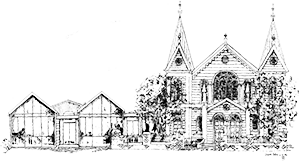Our Parish History
Wesley Church
Our church had its beginnings on 9 June 1839 when Methodist missionaries conducted Wellington’s first service of Christian worship at Te Aro Pa. The spot is marked by a memorial stone in Te Aro Park (at the corner of Taranaki, Manners and Dixon Streets). The first church was built there and later churches were built on the property at the corner of Manners and Cuba Streets. Part of this site (Te Aro Court) still belongs to Wesley Church. The last of the Manners Street churches was destroyed by fire in June 1879 and this led to the purchase of the acre in Taranaki Street and the building of the present church.
The church, designed by Thomas Turnbull, was opened on 14 March 1880 and the name, Wesley Church, adopted a week later. The interior of the church was remodelled to its present form in 1962-63. Further restoration was carried out after fire severely damaged the front of the church in January 1982. The church was closed following the Parish service of Holy Communion of Sunday 3rd November 2019 for extensive seismic strengthening. The church was reopened at Easter 2021.
Today, as well as providing for the varied activities of all the congregations, the property houses Wesley Community Action, the Wesley Counselling Service, SPELD (Supporting People Who Learn Differently), as well as Café Panama on the Taranaki Street frontage.
In 1995 a new building was opened to accommodate the increasing needs of the congregations, and to better serve the community. This occupied recently purchased land between the church and York Street and houses the Parish Office, ministers’ offices, counselling rooms and a large hall and kitchen.
Other buildings on the property include the ‘Old Hall’, built in 1882. Inside the hall is the Wesley Sunday School commemorative mural, painted in 1908 (pictured above). Conservation work was carried out in January 2011 by Phillipa Durkin, a Paper Conservator from Te Papa, aided by a donation by the late Naomi Morton, a beloved member of the parish.
Also on the property is the the Drama Christi Studio, built as an infant schoolroom in 1905 and used by Drama Christi since 1970. A concrete building at the rear of the property, built in 1968, now houses Wesley Community Action.
The Organ
The pipe organ in Wesley Church was built in 1879 by Conacher & Company of Huddersfield, England, for the Manners Street church. That church was destroyed by fire before the organ arrived and it was installed for the opening of the new Taranaki Street church in 1880. The organ was originally sited in the Choir Gallery which at that time occupied the eastern end of the church. It was moved to its present location in 1962 when the renovations were made.
Originally built with a mechanical (tracker) action, the organ was changed to pneumatic action during a major rebuild by Norman & Beard about 1908. The console was detached in 1930. It was converted to electro-pneumatic action in 1962 when being shifted to the present position. The organ has two 56 note manuals and a 30 note pedalboard. It has 23 speaking stops.
Symbols in the Church
The stained glass representation of a dove was given in memory of Ernest Crane, a noted pacifist. The embroidered pulpit and lectern falls are the work of a group of women over a period of years. Four sets are used for the appropriate times of the church year.
GREEN – Symbolising the fruitfulness of the working life. It is the work day set, used between Pentecost and Advent, and Epiphany and Lent.
PURPLE – The liturgical colour of preparation and penance, used during Advent and Lent.
WHITE – This is a celebration set used for Christmas, Easter and special festivals. The design emphasises our place in the city.
RED – The colour associated with Pentecost and the Saints. The design reflects the unpredictability of the movement of the Holy Spirit.
Four banners permanently hanging in the sanctuary represent the life of the four congregations who meet at Wesley Church.

